Study on the Coupling Effect of Stress Field and Gas Field in Surrounding Rock of Stope and Gas Migration Law
Abstract
:1. Introduction
2. Distribution Characteristics of Mining Stress in Working Face
3. Numerical Simulation of Failure Field and Stress Field in Working Face
3.1. Numerical Model Establishment
3.2. Failure Characteristics of Roof and Overlying Strata
3.3. Evolution Law of Cracks in Roof and Overlying Strata
3.4. Distribution Characteristics of Stress Field in Working Face
4. Analysis of Coupling Effect between Stress Field and Gas Field
5. Gas Migration Law and Drainage Engineering Test in Working Face
5.1. Gas Migration and Accumulation Law in Roof and Overlying Strata Failure Field
5.2. Test Study on Gas Drainage Technology by Directional Borehole in Fractured Zone
6. Conclusions
- (1)
- With the working face advancing forward, the roof cracks experienced the process of “opening-closing”, and the stress experienced the process of “relaxation-concentration-stable”. When the height of crack development and the peak stress of the roof of the working face reach a stable state, the height of crack development is about 60~67.2 m and the peak stress is about 1.56~1.97 times the original rock stress.
- (2)
- The changing trend of gas seepage and gas pressure is controlled by the stress change of the working face, which has a typical coupling effect. With the increase in stress in the advancing direction of the working face, the gas pressure and gas seepage also increase. The peak position of gas pressure is the farthest from the coal wall (22.5~25 m) ahead of the working face, followed by the peak of stress (12.5~15 m) and the peak of gas seepage (10~12.5 m).
- (3)
- There is a certain correlation between coal seam permeability and gas seepage. Under the action of high stress near the working face, the pores and cracks in the coal and rock mass further develop. The permeability of coal and rock mass increases, the gas seepage increases, and the gas pressure decreases at this time.
- (4)
- The stress value and the influence range of high stress on the coal body in the working face on the tailgate side are generally larger than those in the working face on the headgate side, but the gas pressure is opposite. Generally, the gas seepage of the coal body in the working face and the fractured zone above the tailgate side is higher than that on the headgate side.
- (5)
- Mining cracks and strata separation spaces provide a good channel and space for gas migration and accumulation. Along the advancing direction of the working face, the gas is mainly concentrated in the crack space above the roof separation zone, and the accumulation position moves forward. Along the layout direction of the working face, there is gas accumulation in the roof of the tailgate side and the crack space of overlying strata.
- (6)
- Based on the law of gas migration and distribution, the gas drainage technology of directional boreholes in fractured zones is put forward. The overall gas drainage effect is remarkable, which effectively reduces the gas concentration of 30~36% in the upper corner of the working face and the tailgate.
Author Contributions
Funding
Data Availability Statement
Conflicts of Interest
References
- Jia, Z.; Ye, Q.; Li, H. Damage Assessment of Roadway Wall Caused by Dynamic and Static Load Action of Gas Explosion. Processes 2023, 11, 580. [Google Scholar] [CrossRef]
- Waloski, R.; Korzeniowski, W.; Bołoz, Ł.; Rączka, W. Identification of Rock Mass Critical Discontinuities While Borehole Drilling. Energies 2021, 14, 2748. [Google Scholar] [CrossRef]
- Shu, L.Y.; Wang, K.; Liu, Z.S.; Zhao, W.; Zhu, N.N.; Lei, Y. A novel physical model of coal and gas outbursts mechanism: Insights into the process and initiation criterion of outbursts. Fuel 2022, 323, 124305. [Google Scholar] [CrossRef]
- Petkovic, M.; Chen, Y.; Gamrath, I.; Gotzes, U.; Hadjidimitrou, N.S.; Zittel, J.; Xu, X.F.; Koch, T. A hybrid approach for high precision prediction of gas flows. Energy Syst. 2021, 13, 1–26. [Google Scholar] [CrossRef]
- Lei, Y.; Cheng, Y.P.; Wang, L.; Ren, T.; Li, Q.Y. Potential infrasonic tremors in coal seam systems: Implications for the prediction of coal and gas outbursts. Fuel 2022, 326, 125000. [Google Scholar] [CrossRef]
- Ziętek, B.; Banasiewicz, A.; Zimroz, R.; Szrek, J.; Gola, S. A Portable Environmental Data-Monitoring System for Air Hazard Evaluation in Deep Underground Mines. Energies 2020, 13, 6331. [Google Scholar] [CrossRef]
- Cheng, L.; Ge, Z.; Chen, J.; Ding, H.; Zou, L.; Li, K. A Sequential Approach for Integrated Coal and Gas Mining of Closely-Spaced Outburst Coal Seams: Results from a Case Study Including Mine Safety Improvements and Greenhouse Gas Reductions. Energies 2018, 11, 3023. [Google Scholar] [CrossRef]
- Lalik, K.; Dominik, I.; Skrzypkowski, K.; Korzeniowski, W.; Zagórski, K. Self-Excited Acoustical Measurement System for Rock Mass Stress Mapping. Sensors 2021, 21, 6749. [Google Scholar] [CrossRef] [PubMed]
- Szlązak, N.; Swolkień, J.; Kamiński, P. Design of Coal Seam Exploitation in Methane Hazard Conditions: A Case Study. Energies 2023, 16, 365. [Google Scholar] [CrossRef]
- Xiong, Y.; Kong, D.Z.; Wen, Z.J.; Wu, G.Y.; Liu, Q.Z. Analysis of coal face stability of lower coal seam under repeated mining in close coal seams group. Sci. Rep. 2022, 12, 509. [Google Scholar] [CrossRef]
- Li, X.B.; Ji, D.L.; Han, P.H.; Li, Q.S.; Zhao, H.B.; He, F.L. Study of water-conducting fractured zone development law and assessment method in longwall mining of shallow coal seam. Sci. Rep. 2022, 12, 7994. [Google Scholar] [CrossRef] [PubMed]
- Zhang, F.; Zhang, J. Research on Joint Protection Layers and Gas Prevention Technology in Outburst Coal Seams. Sustainability 2022, 14, 8859. [Google Scholar] [CrossRef]
- Wang, G.; Fan, C.; Xu, H.; Liu, X.; Wang, R. Determination of Long Horizontal Borehole Height in Roofs and Its Application to Gas Drainage. Energies 2018, 11, 2647. [Google Scholar] [CrossRef]
- Qian, M.G.; Xu, J.L. Study on the “O–SHAPE” circle distribution characteristics of mining-induced fractures in the overlaying strata. J. China Coal Soc. 1998, 23, 20–23. [Google Scholar]
- Li, S.G.; Lin, H.F.; Zhao, P.X.; Xiao, P.; Pan, H.Y. Mining fissure elliptic paraboloid zone and dynamic evolution of coal and methane mining. J. China Coal Soc. 2014, 39, 1455–1462. [Google Scholar]
- Lin, H.F.; Li, S.G.; Cheng, L.H.; Wang, H.S. Experimental analysis of dynamic evolution model of fracture zone caused by overburden mining. J. Min. Saf. Eng. 2011, 28, 298–303. [Google Scholar]
- Lin, H.F.; Wang, X.; Xu, P.Y.; Kong, X.G.; Shuang, H.Q.; Zhao, P.X. Evolution characteristics analysis and engineering application of pressure-relieved gas reservoir in extra-thick coal seam mining. Coal Sci. Technol. 2023, 51, 173–182. [Google Scholar] [CrossRef]
- Xu, X.; Kong, D.Z.; Xiong, Y.; Chen, F. Evolution Regularity and Control Technology of Coal Face Rupture Induced by the movement of Overlying Strata Under the Influence of Mining. Min. Metall. Explor. 2023, 40, 435–452. [Google Scholar] [CrossRef]
- Wang, G.; Wu, M.M.; Wang, R.; Xu, H.; Song, X. Height of the mining-induced fractured zone above a coal face. Eng. Geol. 2017, 216, 140–152. [Google Scholar] [CrossRef]
- Li, L.; Wu, G.; Liu, Q. Study on Overburden Movement and Fissure Evolution Law of Protective Layer Mining in Shallow Coal Seam. Energies 2022, 15, 1831. [Google Scholar] [CrossRef]
- Zhao, Y.; Lin, B.Q.; Liu, T.; Zheng, Y.N.; Kong, J.; Li, Q.Z.; Song, H.R. Mechanism of multifield coupling-induced outburst in mining-disturbed coal seam. Fuel 2020, 272, 117716. [Google Scholar] [CrossRef]
- Zhang, B.C.; Liang, Y.P.; Sun, H.T.; Wang, K.Q.; Zou, Q.L.; Dai, J.H. Evolution of mining-induced fractured zone height above a mined panel in longwall coal mining. Arab. J. Geosci. 2022, 15, 6. [Google Scholar] [CrossRef]
- Zhang, F.; Wang, G.; Wang, B. Study and Application of High-Level Directional Extraction Borehole Based on Mining Fracture Evolution Law of Overburden Strata. Sustainability 2023, 15, 2806. [Google Scholar] [CrossRef]
- Nian, F.; Ju, F.; Zheng, C.; Wu, H.; Cheng, X. Effects of Coal Permeability Anisotropy on Gas Extraction Performance. Processes 2023, 11, 1408. [Google Scholar] [CrossRef]
- Zhang, C.L.; Xu, J.; Peng, S.J.; Li, Q.X.; Yan, F.Z.; Chen, Y.X. Dynamic behavior of gas pressure and optimization of borehole length in stress relaxation zone during coalbed methane production. Fuel 2018, 233, 816–824. [Google Scholar] [CrossRef]
- Zhang, D.Y.; Zhang, M.B.; Wang, L.K.; Zeng, R.P.; Wang, J.B. Determination and Application of Reasonable Levels for Highly Directional Long Boreholes in Deep Outburst Coal Seams. Geofluids 2022, 2022, 3621921. [Google Scholar] [CrossRef]
- Liu, C.F.; Zhang, L.; Li, Y.C.; Liu, F.G.; Martyushev, D.A.; Yang, Y.F. Effects of microfractures on permeability in carbonate rocks based on digital core technology. Adv. Geo-Energy Res. 2022, 6, 86–90. [Google Scholar] [CrossRef]
- Dzhioeva, A.K.; Brigida, V.S. Spatial non-linearity of methane release dynamics in underground boreholes for sustainable mining. J. Min. Inst. 2020, 245, 522–530. [Google Scholar] [CrossRef]
- Zhang, P.S.; Sun, B.Y. Distribution characteristics of the advance abutment pressure in a deep stope. J. Geophys. Eng. 2020, 17, 686–699. [Google Scholar] [CrossRef]
- Xie, J.L.; Xu, J.L.; Wang, F. Mining-induced stress distribution of the working face in a kilometer-deep coal mine—A case study in Tangshan coal mine. J. Geophys. Eng. 2018, 15, 2060–2070. [Google Scholar] [CrossRef]
- Xiong, Y.; Yang, S.L.; Kong, D.Z.; Song, G.F.; Ma, Z.Q.; Zuo, Y.J. Analysis on early warning of coal sample failure based on crack development law and strain evolution characteristics. Eng. Fail. Anal. 2023, 148, 107170. [Google Scholar] [CrossRef]
- Izadi, G.; Wang, S.G.; Elsworth, D.; Liu, J.S.; Wu, Y.; Pone, D. Permeability evolution of fluid-infiltrated coal containing discrete fractures. Int. J. Coal Geol. 2010, 85, 202–211. [Google Scholar] [CrossRef]
- Li, Z.; Wang, L.; Ding, K.; Ren, B.; Wang, S.; Jiang, C.; Pan, Z. Study on Fracture and Seepage Evolution Law of Stope Covered by Thin Bedrock under Mining Influence. Minerals 2022, 12, 375. [Google Scholar] [CrossRef]

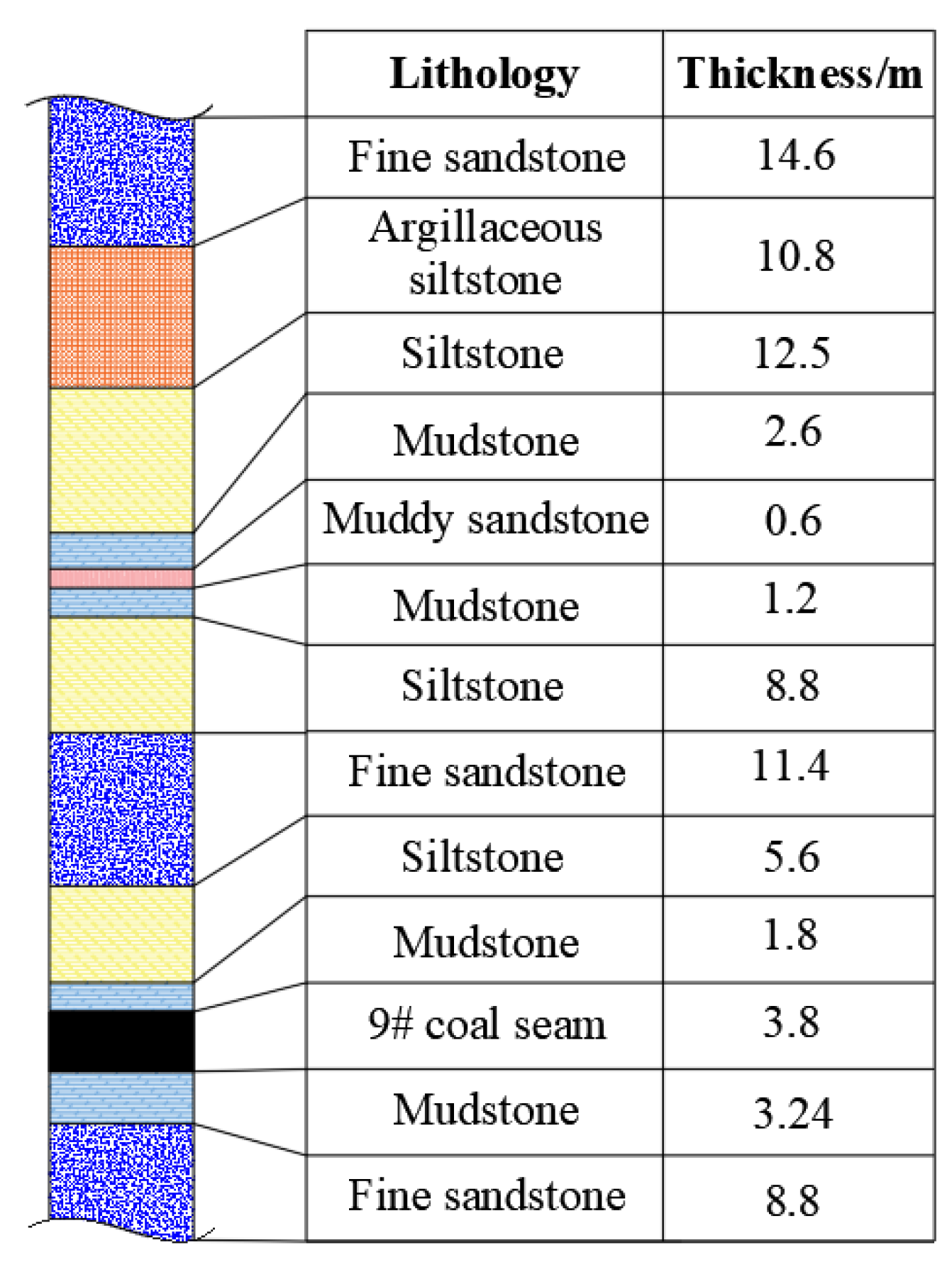
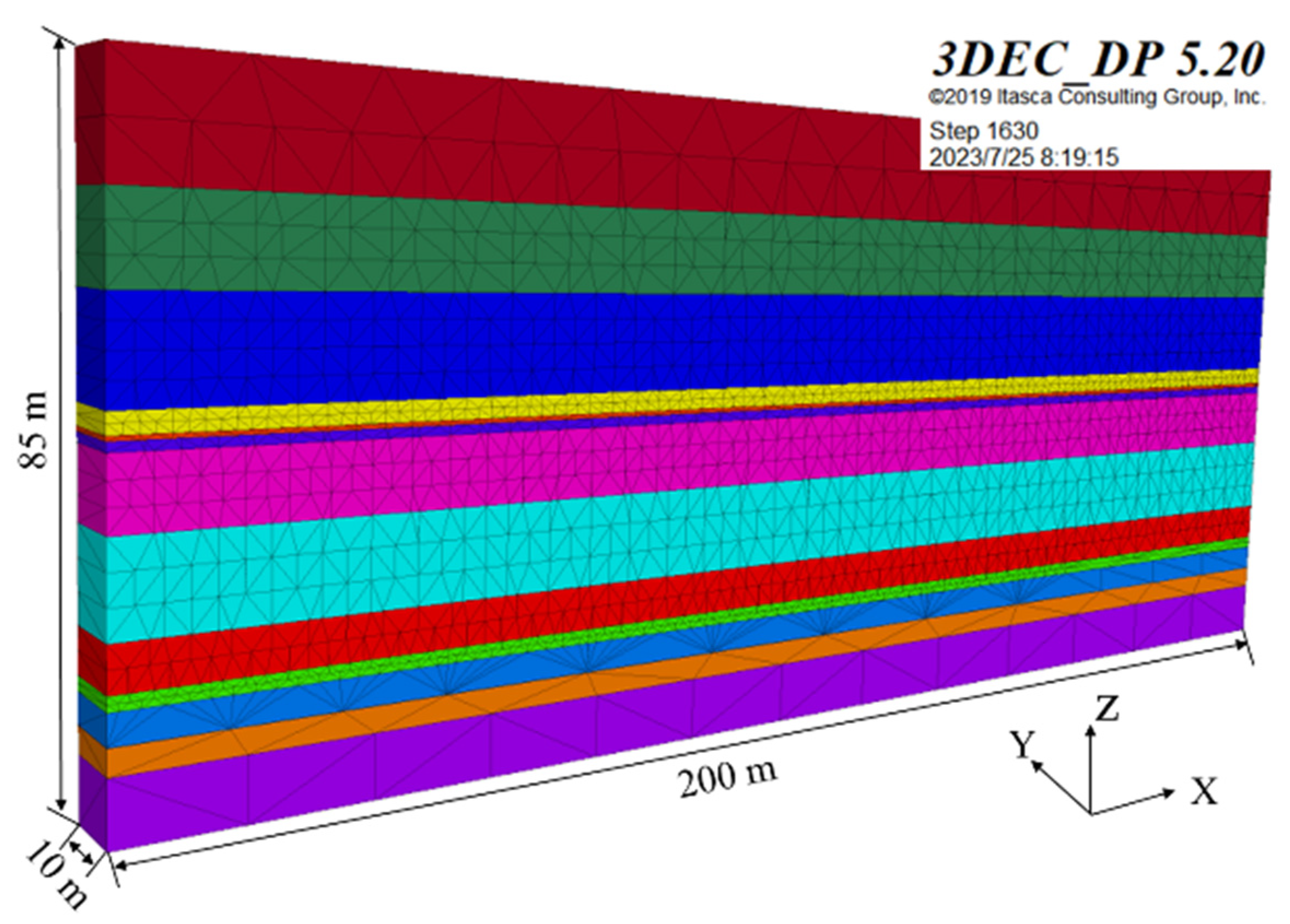
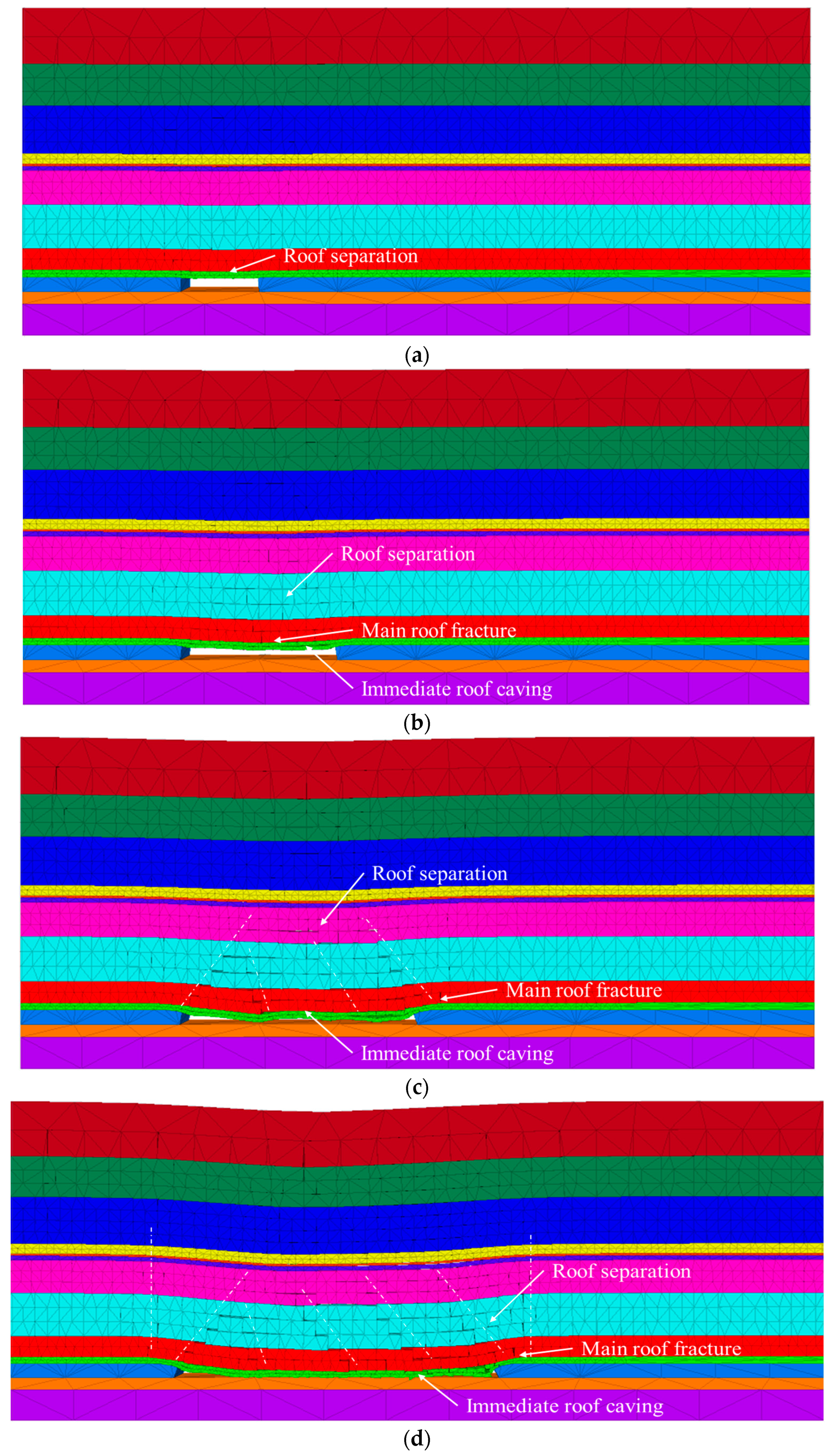



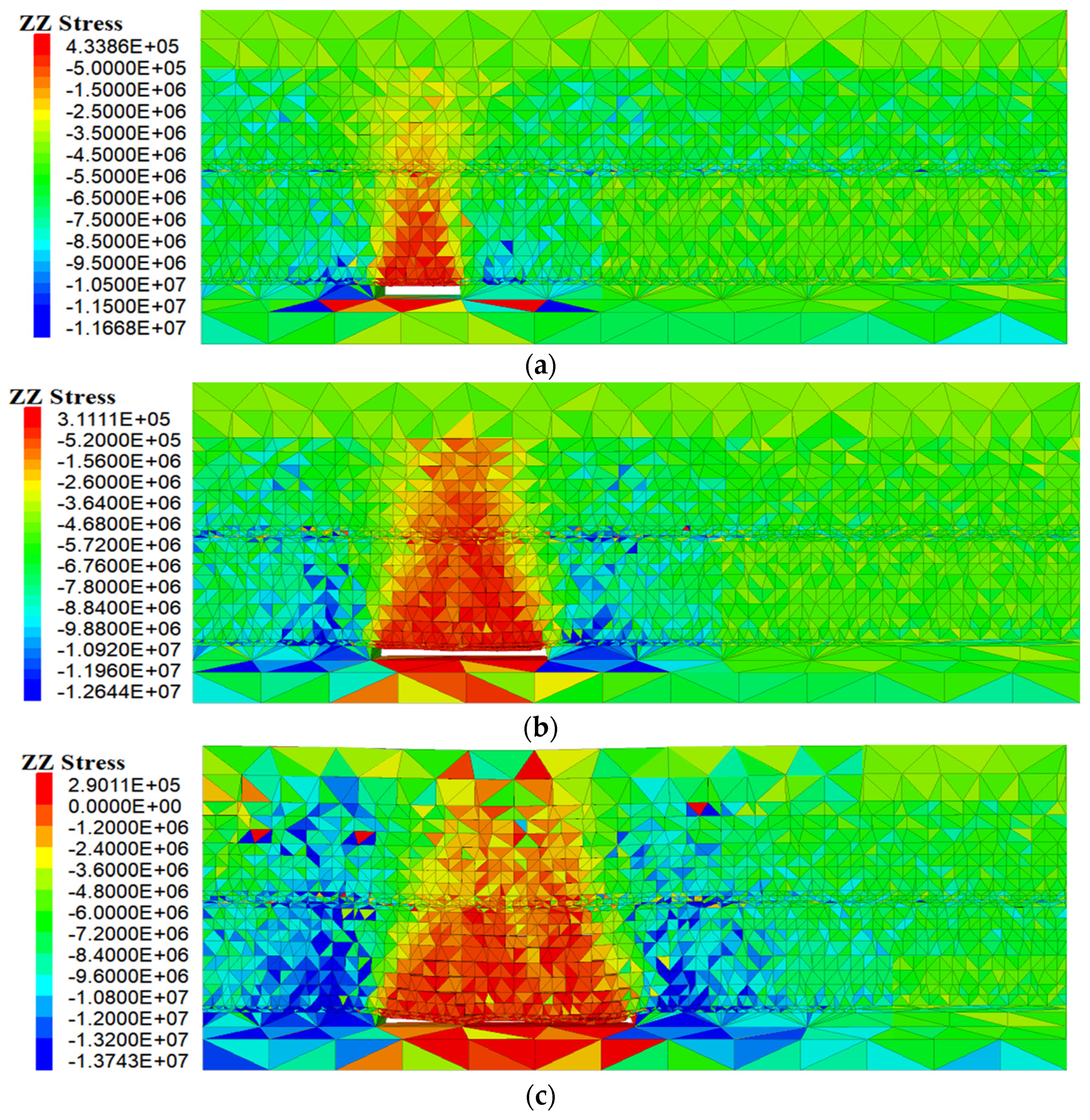
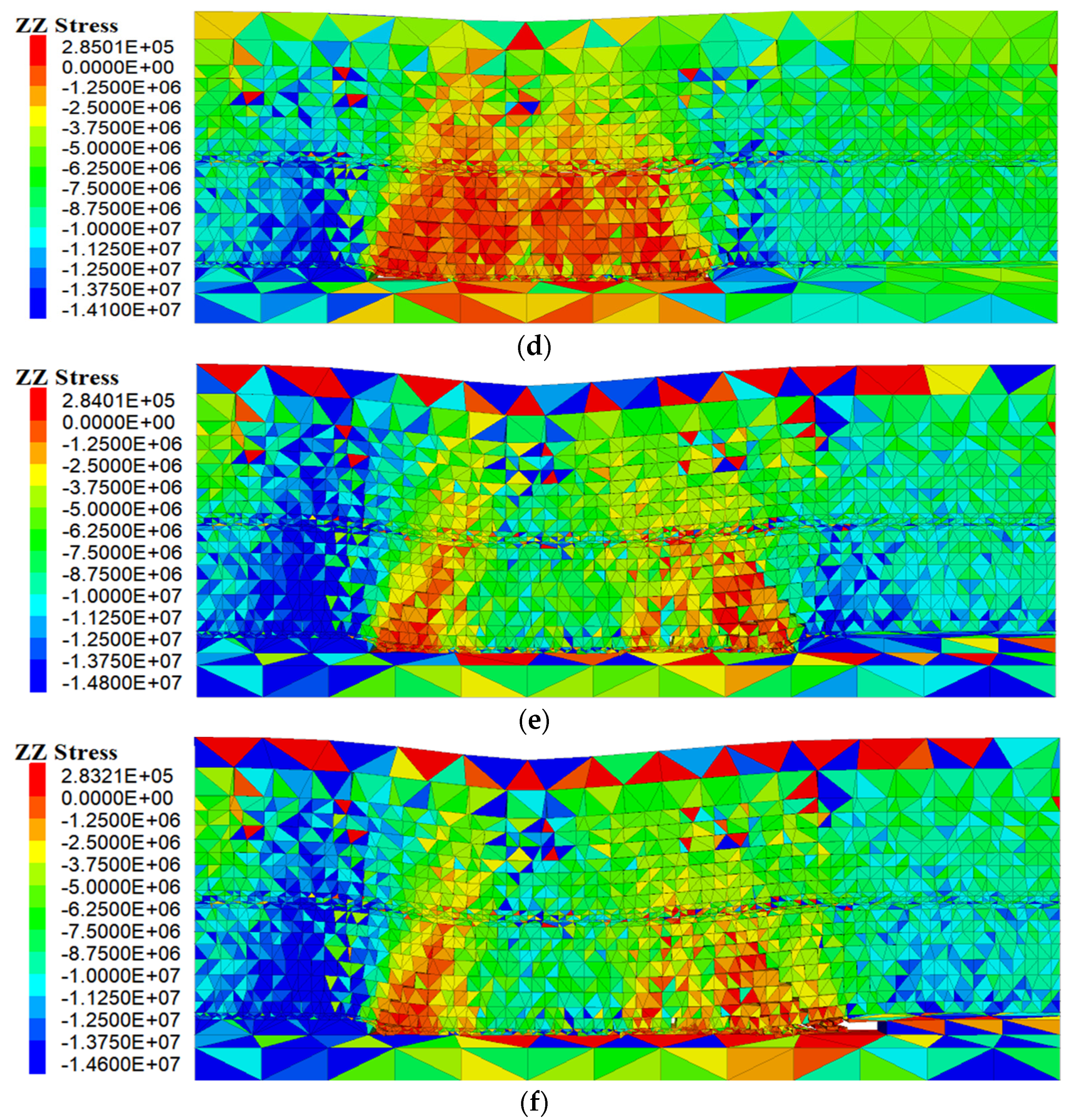
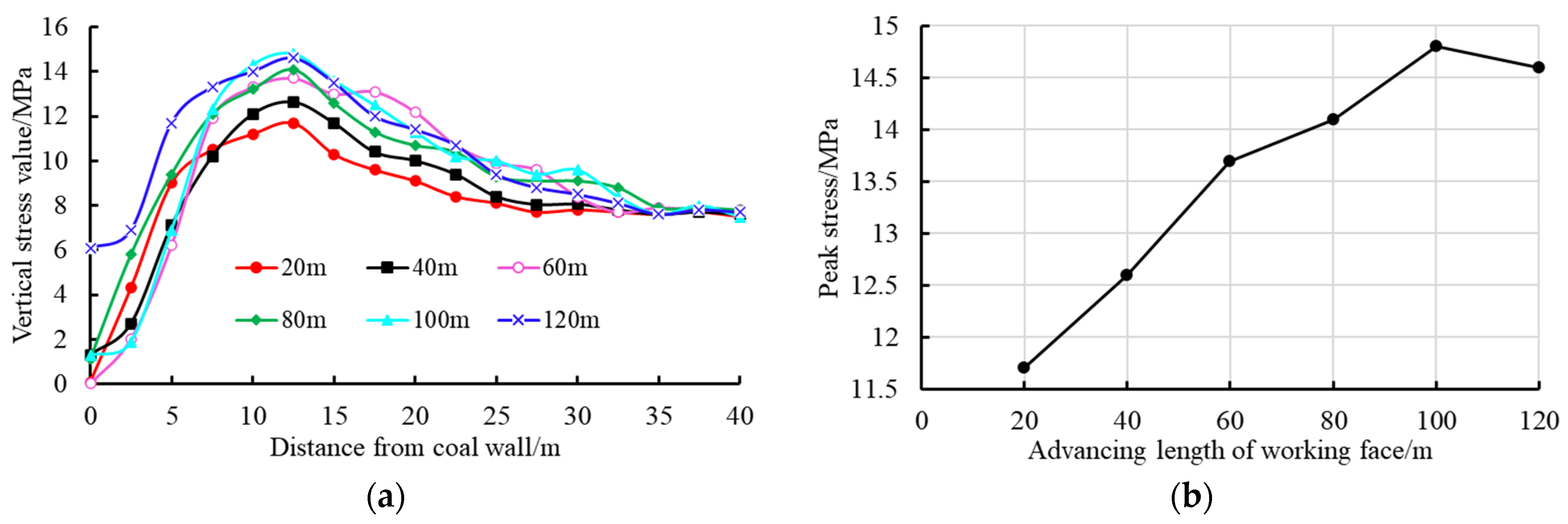
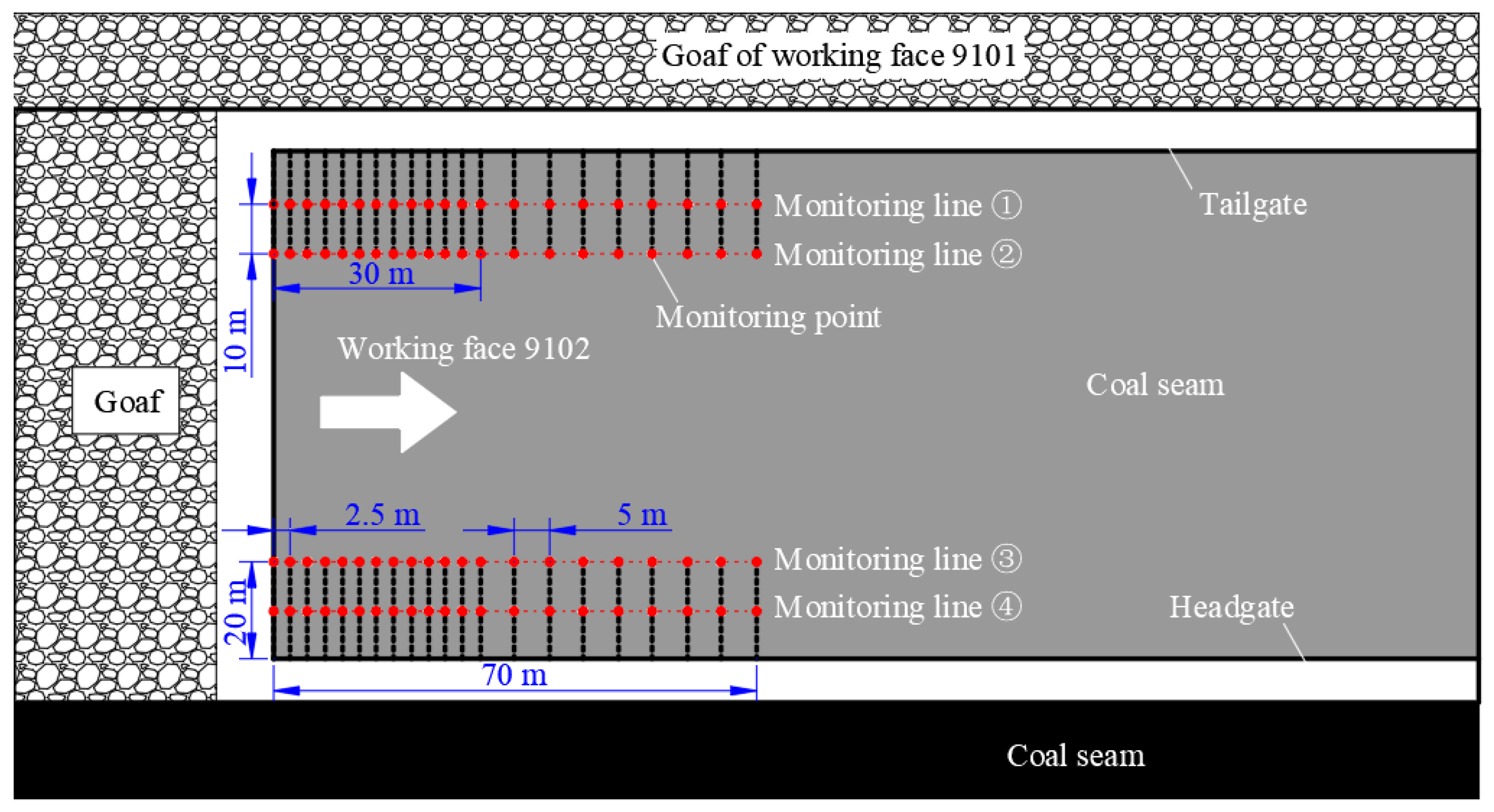
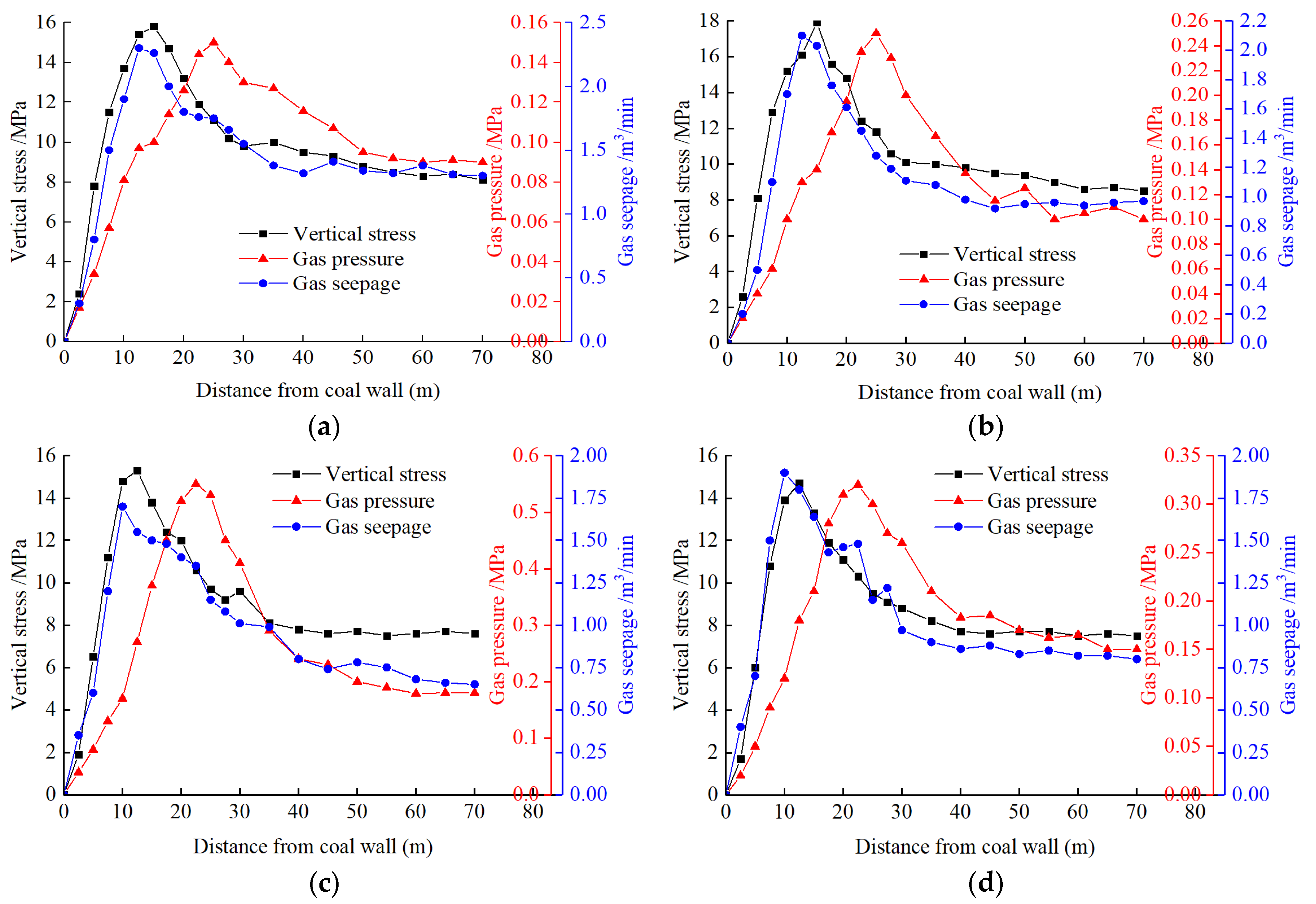

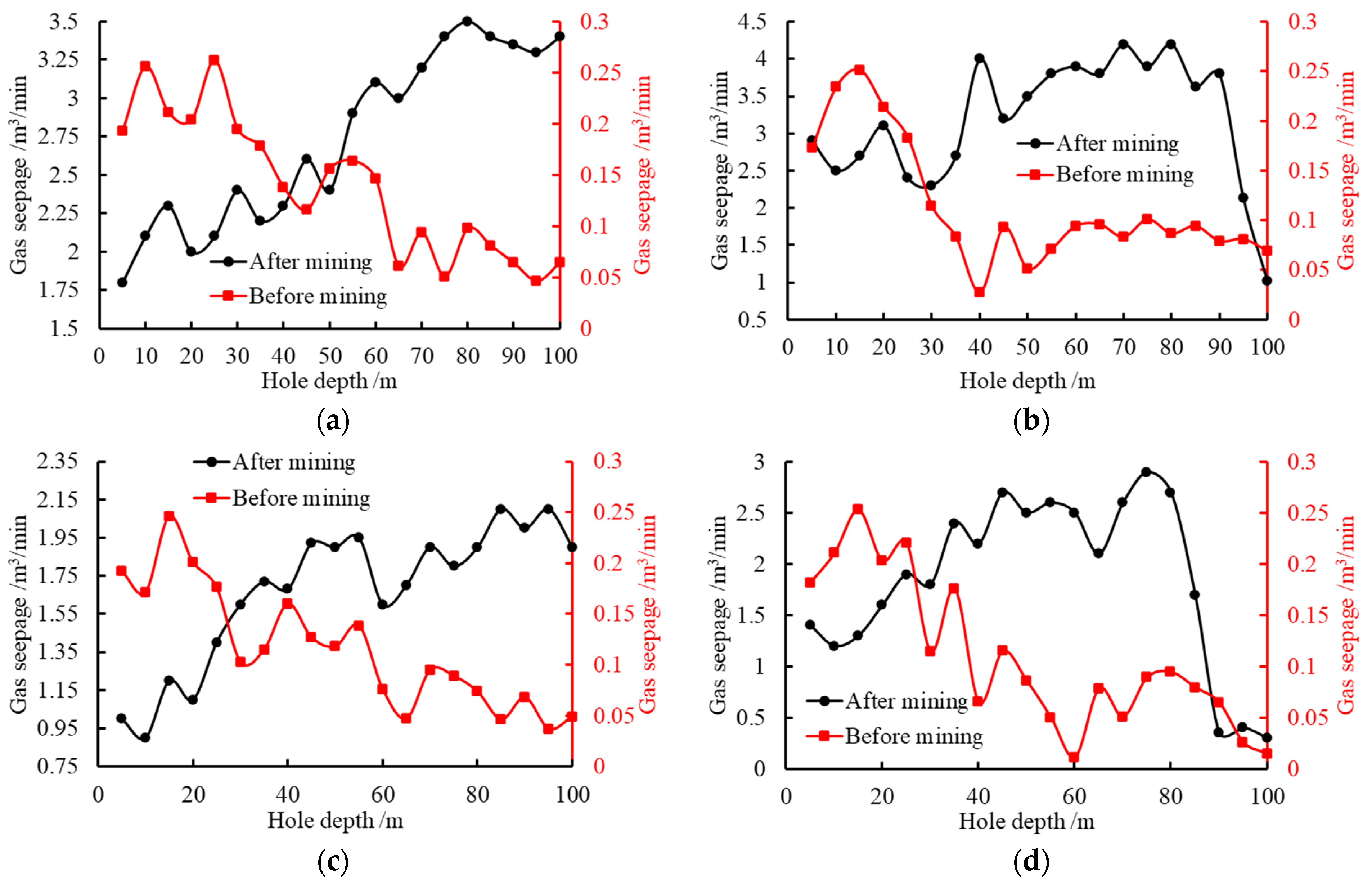
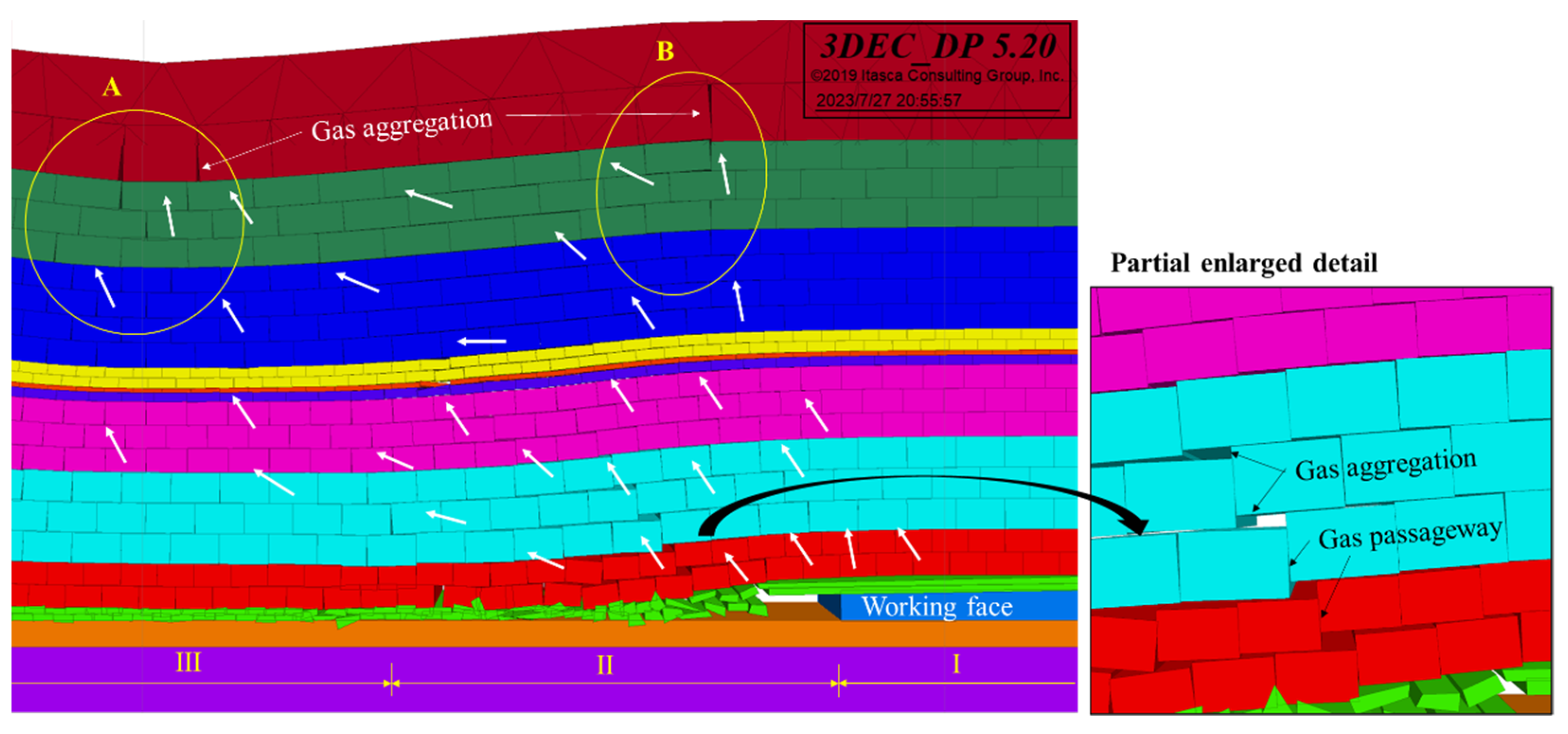

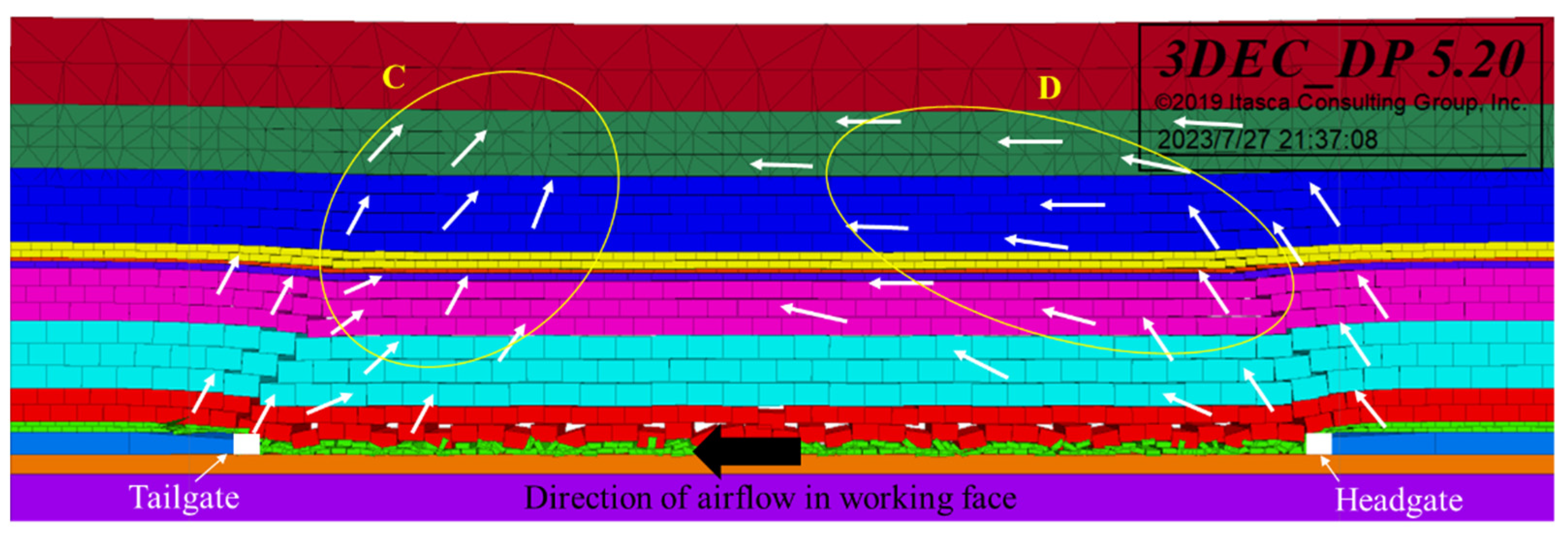
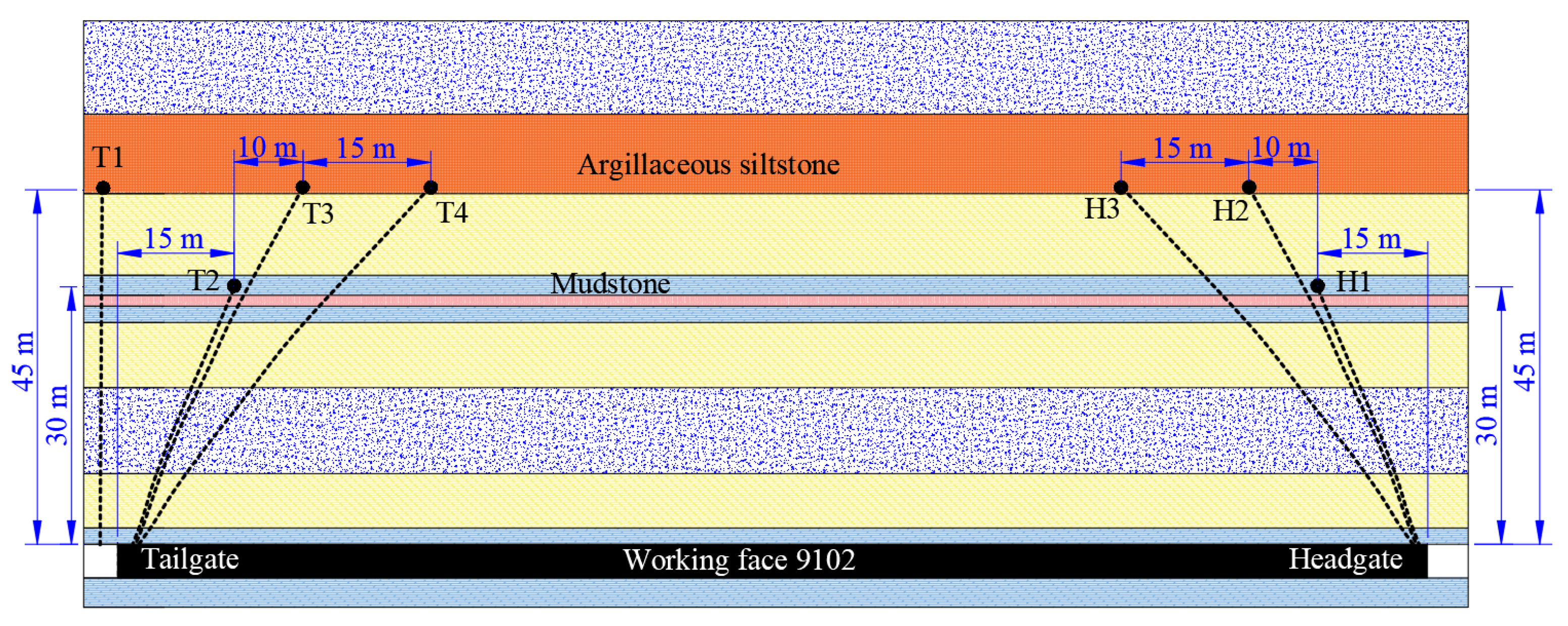


| Lithology | Unit Weight kN/m3 | Average Thickness/m | Elastic Modulus/GPa | Poisson Ratio | Cohesion/MPa | Internal Friction Angle/° | Tensile Strength/MPa |
|---|---|---|---|---|---|---|---|
| Fine sandstone | 2.54 | 14.6 | 18 | 0.29 | 5.2 | 39 | 7.2 |
| Argillaceous siltstone | 2.5 | 10.8 | 16 | 0.15 | 4.6 | 36 | 6.2 |
| Siltstone | 2.46 | 12.5 | 16.6 | 0.17 | 5.5 | 38.7 | 7.15 |
| Mudstone | 2.37 | 2.6 | 15.6 | 0.18 | 2.2 | 40 | 7.05 |
| Muddy sandstone | 2.32 | 0.6 | 7.35 | 0.16 | 2.99 | 26.2 | 1.1 |
| Mudstone | 2.35 | 1.2 | 16 | 0.17 | 2.2 | 25 | 1.5 |
| Siltstone | 2.44 | 8.8 | 18.6 | 0.17 | 3.5 | 32 | 2.8 |
| Fine sandstone | 2.54 | 11.4 | 18 | 0.29 | 5.2 | 39 | 7.2 |
| Siltstone | 2.44 | 5.6 | 18.6 | 0.17 | 3.5 | 32 | 2.8 |
| Mudstone | 2.1 | 1.8 | 13 | 0.21 | 2.2 | 35 | 3.15 |
| 9# coal seam | 1.35 | 3.8 | 1.7 | 0.32 | 1.8 | 20 | 0.8 |
| Mudstone | 2.1 | 3.24 | 13 | 0.21 | 2.1 | 35 | 3.18 |
| Fine sandstone | 2.54 | 8.8 | 18 | 0.29 | 5.2 | 34 | 2.2 |
| Lithology | Elastic Modulus/GPa | Normal Stiffness/GPa | Tangential Stiffness/GPa |
|---|---|---|---|
| Fine sandstone | 2.34 | 4.7 | 3.6 |
| Argillaceous siltstone | 1.62 | 3.22 | 2.39 |
| Siltstone | 1.54 | 3.01 | 2.28 |
| Mudstone | 1.07 | 2.41 | 1.96 |
| Muddy sandstone | 1.26 | 2.52 | 2.1 |
| Mudstone | 1.07 | 2.41 | 1.96 |
| Siltstone | 1.54 | 3.01 | 2.28 |
| Fine sandstone | 2.34 | 4.7 | 3.6 |
| Siltstone | 1.54 | 3.01 | 2.28 |
| Mudstone | 1.07 | 2.41 | 1.96 |
| 9# coal seam | 0.33 | 1.25 | 1.02 |
| Mudstone | 1.07 | 2.41 | 1.96 |
| Fine sandstone | 2.34 | 4.7 | 3.6 |
Disclaimer/Publisher’s Note: The statements, opinions and data contained in all publications are solely those of the individual author(s) and contributor(s) and not of MDPI and/or the editor(s). MDPI and/or the editor(s) disclaim responsibility for any injury to people or property resulting from any ideas, methods, instructions or products referred to in the content. |
© 2023 by the authors. Licensee MDPI, Basel, Switzerland. This article is an open access article distributed under the terms and conditions of the Creative Commons Attribution (CC BY) license (https://creativecommons.org/licenses/by/4.0/).
Share and Cite
Li, S.; Wang, Z. Study on the Coupling Effect of Stress Field and Gas Field in Surrounding Rock of Stope and Gas Migration Law. Energies 2023, 16, 6672. https://doi.org/10.3390/en16186672
Li S, Wang Z. Study on the Coupling Effect of Stress Field and Gas Field in Surrounding Rock of Stope and Gas Migration Law. Energies. 2023; 16(18):6672. https://doi.org/10.3390/en16186672
Chicago/Turabian StyleLi, Shizhe, and Zhaofeng Wang. 2023. "Study on the Coupling Effect of Stress Field and Gas Field in Surrounding Rock of Stope and Gas Migration Law" Energies 16, no. 18: 6672. https://doi.org/10.3390/en16186672
APA StyleLi, S., & Wang, Z. (2023). Study on the Coupling Effect of Stress Field and Gas Field in Surrounding Rock of Stope and Gas Migration Law. Energies, 16(18), 6672. https://doi.org/10.3390/en16186672







